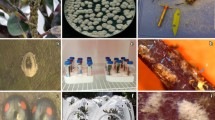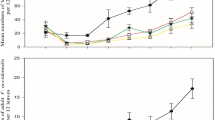Abstract
Information on persistence ofBacillus thuringiensis (Bt) is needed to improve the microbial pest management programs against the pine processionary mothThaumetopoea wilkinsoni in pine forests in Israel. The persistence of the microbe under natural conditions of rain and sunlight was evaluated and is documented here for the first time. Pine saplings were sprayed with three commercialBt products, Foray 48B, Delfin WG and Dipel DF, all used at 32,000 IU mg−1 in a formulation with 1% (w/v) of condensed milk. In experiments conducted in November and December of 2004, the saplings were either exposed to rain and sunlight or were sheltered to avoid these environmental factors. The lowest rainfall recorded in the 8-day experiments was 16.5 mm (test 2) and the heaviest was 71.1 mm (test 1). Solar irradiation ranged from 9.4 to 10.9 MJ m−2. The minimum temperature was close to 10°C and the maximum was less than 23°C. Needles of the treated saplings and their controls were sampled after 0, 1, 5 and 8 days, and were fed to 1st or 2nd instar larvae. Dipel DF persisted better than Delfin WG and still retained its initial activity of 80–100% mortality on day 8 at low rainfall (test 2). Dripping ofBt from upper to lower branches was quantified with the larval bioassays. The milk formulation proved to be an effective rain-fasting adjuvant.
Similar content being viewed by others
References
Brar, S.K., Verma, M., Tyagi, R.D., Valero, J.R. and Surampalli, R.Y. (2006) Screening of different adjuvants for wastewater/wastewater sludge-basedBacillus thuringiensis formulations.J. Econ. Entomol. 90:1065–1079.
Burges, H. (1998) Formulations of Microbial Pesticides. Kluwer Academic Publishers, Dordrecht, the Netherlands.
Demolin, G. and Martin, J. (1998) Control of pine-tree processionary caterpillar. Effectiveness and persistence of the activity of two formulations based onBacillus thuringiensis.Phytoma 507:11–14.
Halperin, J. (1985) Effect of site factors on the population dynamics of the pine processionary caterpillar.Proc. IUFRO Conf. on Site Characteristics and Population Dynamics of Lepidopteran and Hymenopteran Forest Pests (Dornoch, Scotland, 1980), pp. 104–109.
Moore, I., Halperin, J. and Navon, A. (1962) Laboratory and field trials in the bacterial control of the processionary caterpillarThaumetopoea wilkinsoni Tams withBacillus thuringiensis var.thuringiensis Berliner.Isr. J. Agric. Res. 12:167–174.
Morris, O. (1983) Protection ofBacillus thuringiensis from inactivation by sunlight.Can. Entomol. 115:1215–1227.
Navon, A. (1993) Control of lepidopteran pests withBacillus thuringiensis.in: Entwhistle, P., Cory, J., Bailey, M. and Higgs, S. [Eds.]Bacillus thuringiensis, an Environmental Biopesticide: Theory and Practice. John Wiley and Sons, Chichester, UK. pp. 125–146.
Navon, A. (2000) Bioassays ofBacillus thuringiensis products used against agricultural pests.in: Navon, A. and Ascher, K.R.S. [Eds.] Bioassays of Entomopathogenic Microbes and Nematodes. CABI Publishing, Wallingford, UK. pp. 25–40.
Pozsgay, M., Fast, P., Kaplan, H. and Carey, P. (1987) The effect of sunlight on the protein crystals fromBacillus thuringiensis var.kurstaki HD1 and NRD12: A Raman spectroscopic study.J. Invertebr. Pathol. 50:246–253.
Pusztai, M., Fast, P., Gringorten, L., Kaplan, H., Lessard, T. and Carey, P. (1991) The mechanism of sunlight mediated inactivation ofBacillus thuringiensis crystals.Biochem. J. 273:43–47.
SAS Institute (2002). SAS/STAT User’s Guide, version 6.11. Vols. 1&2. SAS Institute, Cary, NC, USA.
van Frankenhuyzen K. (2000) Application ofBacillus thuringiensis in forestry.in: Charles, J.F., Delécluse, A. and Nielsen-LeRoux, C. [Eds.] Entomopathogenic Bacteria: From Laboratory to Field Application. Kluwer Academic Publishers, Dordrecht, the Netherlands. pp. 371–379.
van Frankenhuyzen, K. and Nystrom, C. (1989) Residual toxicity of a high potency formulation ofBacillus thuringiensis to spruce budworm.J. Econ. Entomol. 82:868–872.
Author information
Authors and Affiliations
Corresponding author
Additional information
http://www.phytoparasitica.org posting May 4, 2007.
Rights and permissions
About this article
Cite this article
Gindin, G., Navon, A., Saphir, N. et al. Environmental persistence ofBacillus thuringiensis products tested under natural conditions againstThaumetopoea wilkinsoni . Phytoparasitica 35, 255–263 (2007). https://doi.org/10.1007/BF02981159
Received:
Accepted:
Issue Date:
DOI: https://doi.org/10.1007/BF02981159




